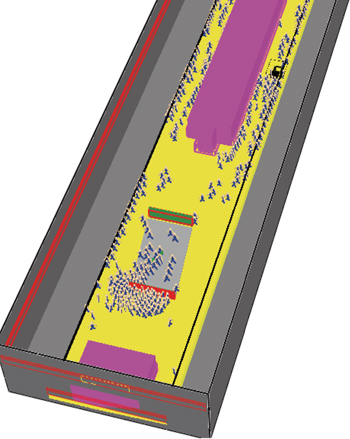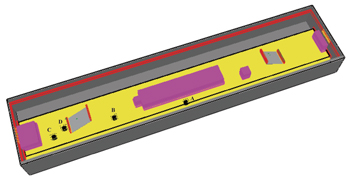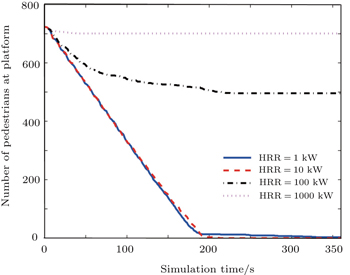† Corresponding author. E-mail:
Project supported by the National Natural Science Foundation of China (Grant Nos. 61322307 and 61233001).
With the development of urban rail transit, ensuring the safe evacuation of pedestrians at subway stations has become an important issue in the case of an emergency such as a fire. This paper chooses the platform of line 4 at the Beijing Xuanwumen subway station to study the emergency evacuation process under fire. Based on the established platform, effects of the fire dynamics, different initial pedestrian densities, and positions of fire on evacuation are investigated. According to simulation results, it is found that the fire increases the air temperature and the smoke density, and decreases pedestrians’ visibility and walking velocity. Also, there is a critical initial density at the platform if achieving a safe evacuation within the required 6 minutes. Furthermore, different positions of fire set in this paper have little difference on crowd evacuation if the fire is not large enough. The suggestions provided in this paper are helpful for the subway operators to prevent major casualties.
Ensuring the safe evacuation of pedestrians has become a key factor in the healthy development of urban rail transit in each country. Currently, the crowding phenomenon is extremely common in subway stations during the morning and evening peak hours, especially in the hub stations such as the Beijing Xuanwumen subway station where the inbound and outbound pedestrians and transfer pedestrians all move within this limited and closed space. Generally, the high density and great psychological pressure of the crowd can easily cause congestion, stranded or even disorder for the complex internal structure of the station. At this time, once emergencies such as fire, gas leak or explosion occur, it is often difficult to get timely and effective evacuation of pedestrians, which can easily result in casualties and property losses. In order to improve the safety factors at subway stations when an emergency occurs, it is necessary to do some preventive work such as controlling the inflows to keep the pedestrian density not very high.
In recent years, various pedestrian dynamics models have been developed to better imitate and understand the behaviors of pedestrian flows. Generally, these methods are divided into two categories: macroscopic models and microscopic models. A macroscopic pedestrian model such as the fluid dynamics model[1] pays more attention on the overall movement dynamics of the crowd, where pedestrian flows are described by average speed, density, and location, etc. Compared with the macroscopic pedestrian model, the emerging microscopic pedestrian model focuses more on the detailed behaviors of each pedestrian. Some representative microscopic models are the cellular automata model,[2] the social force model (SFM),[3] and the agent-based model.[4] These pedestrian models have already been used to study evacuation dynamics in various scenarios such as dormitory[5] and stadium[6] after emergencies.
According to Guoet al.,[7] fire is the main cause of emergencies. They developed an extended heterogenous lattice gas pedestrian model combined with the Fire Dynamics Simulator (FDS),[8] which can provide a spread of information of the fire to simulate pedestrian evacuation in a terrace classroom under fire emergency. Shi et al.[9] proposed an agent-based evacuation model for large public buildings under the fire condition, and the famous FDS was also used to give the realtime fire conditions such as smoke density, temperature and toxic gas density. FDS uses a computational fluid dynamics model to describe the fire-driven fluid flow.[8] The group at VTT Technical Research Center of Finland further developed the software FDS + Evac[10] to simulate pedestrian evacuations under fire, and FDS + Evac is fully embedded in FDS. In FDS + Evac, not only the pedestrian evacuation process under fire but also the human egress process without any fire effect can be simulated.[10] Lei et al.[5] investigated the evacuation process of students from a dormitory by using FDS + Evac without any fire, and compared the simulation results with the experimental results.
According to the code for the design of the metro in China,[11] subway stations should have disaster prevention facilities to prevent fire which should be mainly focused on flood, storm, snow, earthquake, lightning, and parking accidents. By the comprehensive analysis of the causes of accidents in subway stations around the world for the last 150 years, fire accident is the highest frequency disaster which can cause huge losses. Because of the complex structure of the subway station, fire accompanied by the diffuseness of toxic gases is extremely easy to spread. Compared with the conventional indoor fire, the fire accident in subway stations can cause more serious damage to property and casualties. In this paper, we mainly focus on pedestrian evacuation in subway stations under the fire conditions based on FDS + Evac. As far as we know, there is not much research on this topic. Lei et al.[12] studied crowds’ evacuation in a huge terminal subway station using FDS + Evac, however, the fire condition which is a very important factor to affect an evacuation is not considered. The effect of the platform screen door system of the underground railway station on an emergency evacuation under the fire conditions is studied in Ref. [13]. Some detailed problems about pedestrian dynamics under fire in the subway stations need further investigations in this paper.
This paper takes the platform of line 4 in the Beijing Xuanwumen subway station as an example, and the basic attributes of pedestrians at the platform are obtained by the statistical analysis of our survey data. In addition, these basic attributes are as the basic data in the simulation to investigate pedestrian evacuation under the fire. One contribution in this paper is to find the maximum density threshold in the platform which can provide theoretical guidance for the control of inflow in the subway station. Another contribution of this paper is to obtain the realtime effect of fire on the air temperature and pedestrians’ visibility, which can further help us to understand effects of the location of the fire source and the size of the heat release rate (HRR) of the fire on pedestrians’ behavioral characteristics and psychological activities.
This paper continues with the description of FDS + Evac in Section 2. Section 3 gives the framework of the simulated platform and also the composition of pedestrian flow coming from the collected data of the platform. Section 4 studies the effects of fire dynamics, different initial densities of the crowd, and different fire positions on evacuation.
In this paper, FDS + Evac is chosen to simulate the evacuation of pedestrians in the subway station. FDS + Evac, allowing to simulate both pedestrian dynamics and fire dynamics, treats each pedestrian as a separate agent who has his or her own properties. The SFM of Helbing et al.[14] is used as the starting point of the movements of pedestrians in FDS + Evac. Besides, the modification of SFM developed by Langston et al.[15] is also adopted to describe the movement of pedestrians from the one-circle representation to a three-circle one.[10] Pedestrians are driven not only by physical forces but also by desired forces and psychological forces.
In the SFM, pedestrian i is driven by the desired force, 

The desired force 



The interaction force







The interaction force between pedestrian i and walls w,






Here, 





The interactions between the fire and pedestrians are also considered in FDS + Evac. The conditions of fires such as air temperature, air density, smoke, and radiation levels can cause pedestrians to be incapable. The fire condition may also be influenced by opening the windows or doors. In FDS + Evac, pedestrians’ desired walking speed 


Unknown or unfamiliar routes usually have additional threats to the safe evacuation of pedestrians. Because of this reason, few people choose the emergency exit in the case of fire or other emergencies.[10] The familiarity of the exit route and the herding behavior are two very important factors to affect pedestrians’ route selection.[17] The exit selection algorithm embedded in FDS + Evac is based on game theory. According to FDS + Evac Technical Reference and User’s Guide,[10] pedestrians choose a route through which the evacuation is estimated to be the fastest. The estimated evacuation time of pedestrians is based on the distance to the exit and the congestion degree in front of the exit. Besides, the estimated evacuation time is not the only factor in the choice of exit, the embedded algorithm in FDS + Evac also takes the familiar degree of pedestrians to different exits, the visibility near the exit and the fire condition near the exit into consideration. For more details, readers can refer to Ref. [10].
According to FDS User’s Guide,[18] FDS can imitate the spread of smoke and heat from fire by solving a plurality of Navier–Stokes equations, especially the k–ɛ turbulence model.[19] Multiple meshes which are uniformly spaced three-dimensional grids are adopted in FDS to compute the mass and species transport in fire.[20] This paper only gives the description of the computing methods of temperature and visibility in FDS due to the limited space of the paper. We refer readers to Ref. [18] and Ref. [20] for more details of FDS.
FDS Technical Reference Guide[20] gives the detailed computing method of temperature T in each mesh which is obtained from density and species mass fractions:

FDS User’s Guide[18] gives the detailed computing method of pedestrian’s visibility which has a close relationship with the smoke of a fire. The expression for the estimated visibility of pedestrians is

The parameters mentioned in this paper are specified in Table
| Table 1. Parameters in FDS + Evac. . |
The simplified two-dimensional (2D) top view chart of the platform of line 4 at Xuanwumen subway station is shown in Fig.
There are stairs and escalators on both sides of the platform, and the lifts near the middle as shown in Fig.
Pedestrian evacuation at the investigated platform in this paper is different from that in the traditional double exit room. One difference is that the evacuation channels on both sides of the platform are relatively narrow and relatively long because of the special and complex structure of the subway station, so the difficulty of the safety evacuation of pedestrians is relatively large. Besides, the platform surrounded by soil and rock is mostly under the ground, and there are no windows on the platform. The degree of psychological panic of pedestrians often increases in this relatively confined space after a fire has started, thus the evacuation disorder is more serious, so the probability of a stampede accident on the platform is much higher than that in a conventional double exit room. Furthermore, due to the relatively closed space of the platform, heat and smoke can accumulate quickly and cannot dissipate after the fire. Therefore, the air temperature on the platform increases faster and the visual field of pedestrians also decreases faster compared with those in the traditional room.
In this paper, we choose P1 in Fig.
| Table 2. The composition of pedestrian flow. . |
For different types of pedestrians, they have their unique body sizes and velocities in FDS + Evac, we apply the composition of pedestrian flow in Table
| Table 3. Pedestrian parameters for different body types. . |
Based on FDS + Evac, this section first studies the effect of fire dynamics which can result in increasing the air temperature and reducing the pedestrian visibility. Then, the influence of different pedestrian densities on evacuation under fire is investigated to provide the feasible suggestions to the subway operator of line 4. Following it, the comparison of the effects of different fire positions on evacuation is focused on.
In the simulation, it is assumed that fire occurs in the center of the platform as shown in Fig.
 | Fig. 5. The simplified three-dimensional (3D) top view chart of the platform of line 4 at Xuanwumen subway station. |
After fire occurs, the air temperature, the smoke density or other factors may be changed with time, which can result in the change of pedestrians’ visibility, velocity or other properties. By using FDS + Evac, the snapshots of temperature and pedestrians’ visibility at different time instants are obtained in Figs.
The decrease of the radius of pedestrians’ visibility can directly result in the decrease of pedestrians’ velocity in a certain degree. Note that the default radius of visibility is 30 m for all pedestrians in FDS + Evac. Figure
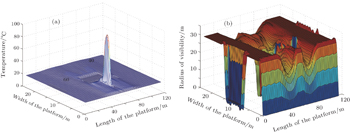 | Fig. 8. Mean temperature and radius of visibility from 300 s to 360 s. (a) Mean air temperature and (b) mean radius of visibility. |
The real time fire conditions directly affect the pedestrians’ movement, and the snapshots of the pedestrian evacuation at different time instants are also collected as shown in Fig.
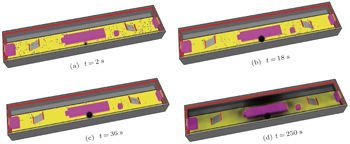 | Fig. 9. Snapshots of pedestrian evacuation at different time instants: (a) t = 2 s, (b) t = 18 s, (c) t = 36 s, and (d) t = 250 s. |
| Table 4. The composition of pedestrians knowing the corresponding stairs/escalators. . |
In order to achieve safe evacuation from the platform of line 4 within the required time of 6 minutes after the fire, we specially set different initial densities of pedestrians at the platform to imitate the crowd evacuation.
Figures
 | Fig. 10. The proportion of evacuated pedestrians from the platform over time for different initial densities. |
During the process of simulations, we can find that when the initial density is relatively low such as 0.2 p/m2 and 0.4 p/m2, pedestrians can walk freely to the stairs/escalators after the fire. Pedestrians, however, find it very hard to move forwards when the initial density is high enough especially around the stairs/escalators a few minutes later, after the fire as figure
In this section, in order to investigate the effect of fire position on evacuation, we set 4 different positions of fires shown in Fig.
The different evacuation effects are shown in Fig.
Based on the software FDS + Evac, in this paper we focused on investigating pedestrian evacuation under fire on the platform of subway line 4 in Beijing Xuanwumen subway station, China. Our simulation results show that the fire increases the air temperature and the smoke density, which can directly result in reducing pedestrians’ visibility and walking velocity. The density of pedestrians on the platform should not be very large, in order to meet the requirement of safe evacuation, there always exists a critical threshold of density, and we found that 1.0 p/m2 is this threshold value for the platform studied in this paper. Furthermore, in comparison with the evacuation results under fire at different positions, it can be found that the position of the fire has little impact on the evacuation within the first required 6 minutes if the fire is not very large. However, when the HRR of the fire near the stair/escalator is large enough, the fire disaster can cause serious loss.
| 1 | |
| 2 | |
| 3 | |
| 4 | |
| 5 | |
| 6 | |
| 7 | |
| 8 | |
| 9 | |
| 10 | |
| 11 | |
| 12 | |
| 13 | |
| 14 | |
| 15 | |
| 16 | |
| 17 | |
| 18 | |
| 19 | |
| 20 |










